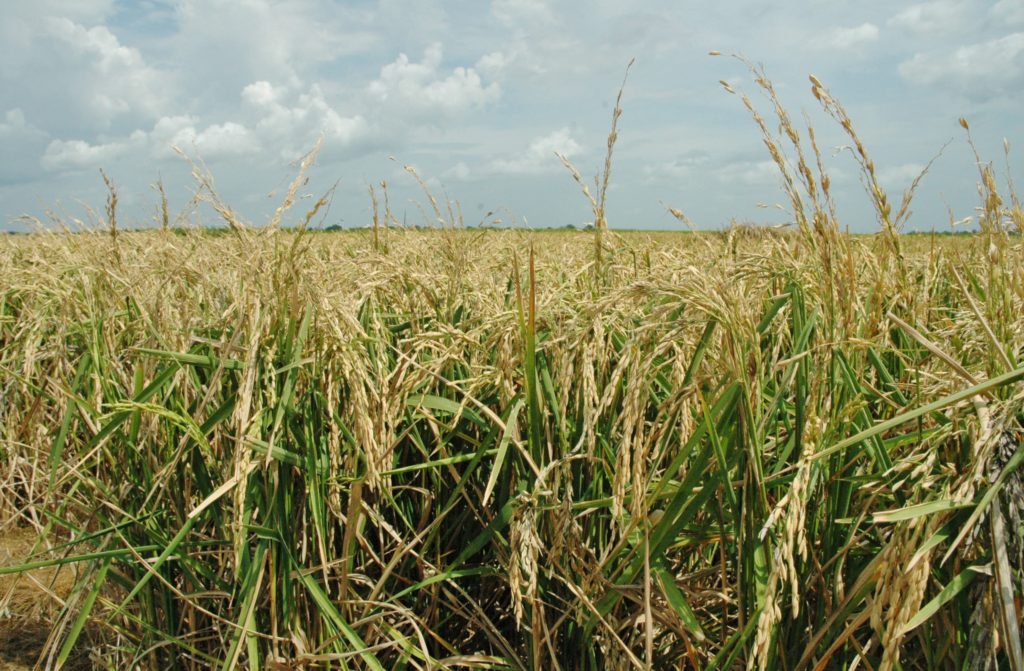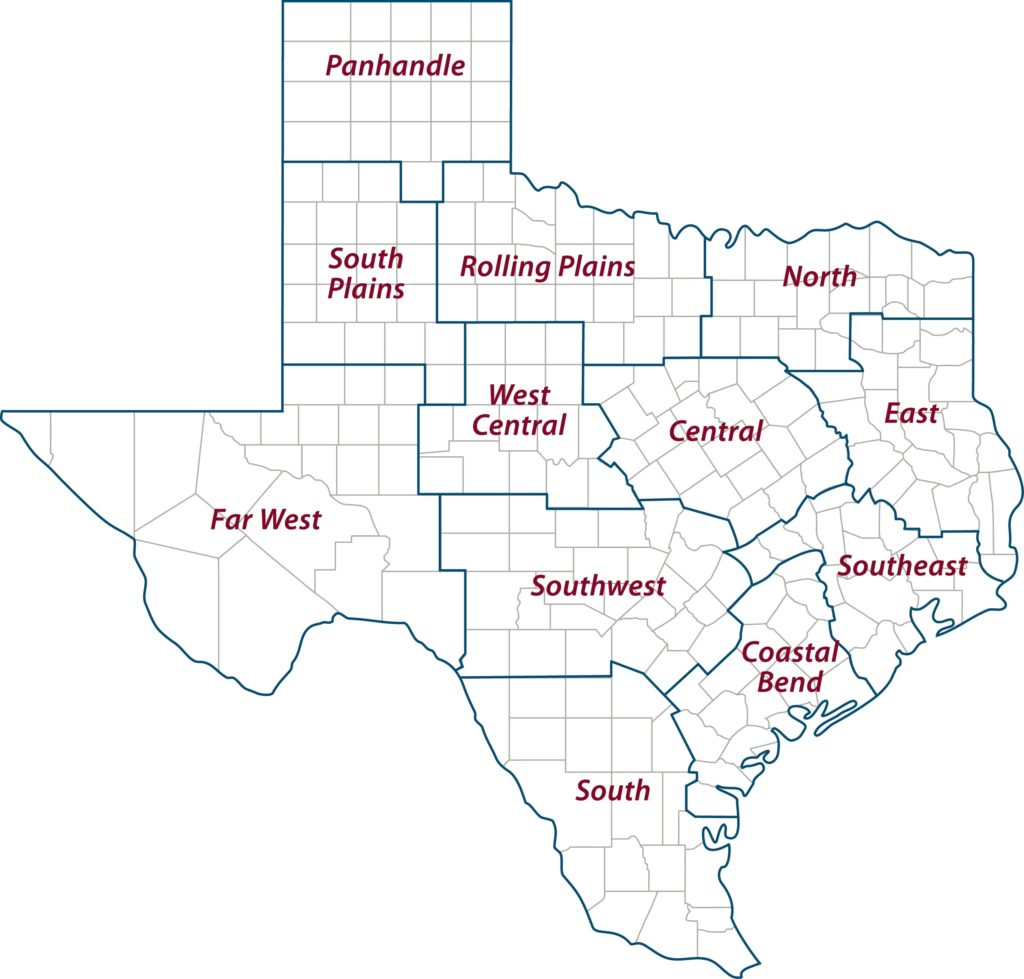Rice crop, market likely up for Texas producers
Texas Crop and Weather Report – Oct. 14, 2020
Early indications show Texas rice farmers produced a bumper crop amid a market that could experience a price increase due to crop losses in other rice-producing states, said a Texas A&M AgriLife Research expert.
Ted Wilson, Ph.D., Texas A&M AgriLife Research and Extension Center director, Beaumont, said high yields and lower-than-expected supplies elsewhere could be good news for Texas rice growers.

“I’m hearing about extremely high yields in the main crop, but I haven’t seen enough data on quality or yields for an assessment,” he said. “From the way growers are talking, it looks like we’ll be closer to 2018 production numbers than 2019.”
Rice crop numbers
Producers yielded 1,300 pounds more per acre in 2018 compared to 2019, Wilson said.
Rice acres were also up this year – 184,400 acres – compared to 2019 – 154,100 acres, he said.
Wilson said rice acres in Texas typically fluctuate based on global market prices.
“The U.S. is a miniscule producer but a major exporter of rice,” he said. “The U.S. typically ranks third to fifth in global rice exports, so the Texas acreage goes up and down based on the supply and demand.”
Wilson suspects U.S. supplies, including growers in Arkansas and northern Louisiana, were negatively impacted by a series of hurricane and tropical storm systems this growing season. The losses could greatly impact the U.S. export market and rice prices.
Arkansas produces half of the nation’s rice, Wilson said. Losses in Louisiana also likely reduced the U.S. production of long-grain rice, which is the primary rice crop for Texas growers.
“In Texas that’s mostly good news for growers,” he said. “But it’s not good for growers in those other states. They just got too much rain at the wrong time. Losses in Arkansas and northern Louisiana may affect global supplies.”
Wilson said a 5%-10% reduction in overall U.S. production due to those crop losses will likely mean rice acres in Texas remain static next year rather than fall.
Crop conditions and ratoon crop
Wilson said dry conditions early in the growing season weren’t ideal for other Texas crops but they were good for rice growers. Producers were able to follow planting with a flush of shallow water that is drained and followed by a subsequent flush as plants grow.
“Drought can mean more flushes are necessary, and that can push water costs up, but they had timely rains,” he said. “Too much rain can cause problems too, but there was little impact to the Texas crop from the storms.”
Wilson said disease and pest pressure were low in 2020 as well. The ratoon crop could face heavier infestations because a Caribbean plant hopper reemerged several years ago and caused some black mold development in late-season fields last year.
It is too early to estimate how well the ratoon crop in Texas will perform, Wilson said. Ratoon crops west of Houston typically perform better during the season because the region has lighter soils, receives less rain and ultimately enjoys an extended growing window.
Around 50% to 75% of the acres planted for the main crop have been ratooned in recent years, he said. But grower surveys are not far enough along to provide a glimpse of what the ratoon crop expectations are this year. There also was some concern about late-season tropical storms or hurricanes negatively impacting the ratoon crop.
Wilson also said Texas rice production was spared major impacts from COVID-19.
“When it comes to weather, the timing of the Texas crop was pretty close to perfect to avoid storm impacts,” he said. “And as far as COVID, there may have been some shipping disruptions at Texas ports, but I think a lot of that was more from storm damage, so it really hasn’t been affected so far.”
AgriLife Extension district reporters compiled the following summaries:

CENTRAL
Conditions were good. Dry conditions prevailed with unseasonably hot temperatures, resulting in some topsoil moisture deficits again. Pastures were still green with warm-season grasses and some winter grasses were beginning to emerge. Hay producers were making last cuttings and baling. Field preparations continued in advance of winter wheat planting. Some winter wheat plantings may be delayed into late October due to recent dryness. Grain harvest was almost complete, and cotton harvest was starting to wrap up. Livestock were in good condition.
ROLLING PLAINS
Conditions were dry and warm. Pastures and water tanks were starting to dry out. Most wheat was planted, but some fields needed rain before planting. Wheat emerged and early planted fields that had moisture looked good. Some areas were reporting armyworms.
COASTAL BEND
Excessive heat prevailed, and no rain was reported. Conditions were very dry again. Fieldwork continued with stalk destruction. The ratoon rice crop was progressing well. Recently planted winter pastures needed rain. Hay fields were being cut and baled, but the season was wrapping up. Hay yields were average, and most ranchers were stocking hay and not selling. Livestock were doing well. There were large sale runs at local auctions as ranchers weaned calves and culled cows. Pecan harvest began, and yields were fair to good.
EAST
Most of the district started to dry. Sabine and Jasper counties received as much as 4 inches from storms generated by Hurricane Delta. Hay production continued but was slowing down. Winter pastures were being planted. Pasture and rangeland conditions were fair to good. Subsoil and topsoil conditions were adequate. Cattle market prices dropped as sale numbers increased. Livestock were in fair to good condition. Fly populations were high. Wild pigs caused damage in the district’s pastures, hay meadows, woodlands and even lawns.
SOUTH PLAINS
Very dry conditions continued with no moisture the past several weeks. Farmers were busy defoliating cotton fields, and a few started stripping dryland fields. The first bales of cotton were ginned. Many producers were beginning harvest with corn, peanuts and cotton. The pumpkin crop was winding down with most producers finishing harvest. Producers were moving to strip cotton. Winter wheat was planted across the district. Irrigated fields of winter wheat were starting to emerge. Cattle were in good condition with supplemental feed.
PANHANDLE
The northeastern parts of the district reported short to adequate subsoil and topsoil moisture. Central and southern areas of the district reported short to very short subsoil and topsoil moisture levels. Pasture and rangeland reported very poor to good. Corn and sorghum were being harvested. Cotton conditions were poor to good. Winter wheat was being planted. Precipitation events were needed to facilitate emergence and growth of recently planted small grains and to recharge soil profile moisture supporting pastures.
NORTH
District soil moisture was short to adequate. Areas were starting to lose topsoil moisture, which delayed some winter pasture plantings. Most days were in the low- to mid-80s with nightly temperatures in the low 60s. Hay producers were trying to get a last cutting. Cotton was being harvested along with some soybeans. Summer pastures were holding strong, but growth was slowing. Livestock were in good condition, but swinging temperatures stressed some livestock.
FAR WEST
Temperatures were above 100-degrees with lows in the mid-50s. No precipitation was reported. Cotton harvest was moving rapidly, but yields were below expectations. Some producers continued to defoliate cotton fields. Wheat planting came to a halt for cotton harvest, and due to lack of soil moisture. Pumpkins were being picked. Producers continued to supplement cattle due to lack of forages. Cattle and livestock looked good. Pecans were filling out.
WEST CENTRAL
Better weather allowed for cotton to be sprayed with harvest aids. Some cotton was harvested, and a lot will be stripped soon. Topsoil moisture was drying up again. Pastures were green, but more rain was needed to keep cool-season grasses and forbs going. Wheat/oat pastures were doing well, but producers were moving round bales to pastures for cattle. Some yearling cattle were being purchased.
SOUTHEAST
Scattered rains were reported, but some areas received significant amounts from Hurricane Delta. Conditions continued to dry in some areas. Some small grains were planted. Rangeland and pasture ratings were excellent to poor with fair being the most common rating. Soil moisture levels ranged from adequate to surplus with adequate levels being the most common.
SOUTHWEST
Dry conditions and above-average temperatures were reported. Producers prepared fields for small grain and spring row crops. Caldwell County reported that most oat and wheat fields were planted. High numbers of livestock were marketed. Livestock conditions were fair to good. Producers were supplementing feed due to drier rangeland conditions. Sutton County reported that fall shearing was mostly complete. Wildlife conditions were good.
SOUTH
Soil moisture levels ranged from very short to adequate with northern parts of the district reporting short to very short levels and southern areas reporting adequate levels. Conditions were warm with temperatures in the 90s and no rainfall. Higher-than-normal temperatures were drying soil moisture rapidly. Cotton harvest continued and should wrap up in most areas next week. Peanut harvest started. Pasture and rangeland conditions were starting to decline due to lack of rainfall. Producers reported tanks were still in good condition, and pasture conditions were fair with some supplemental feeding taking place. Armyworm damages were reported. Wheat and fall forage plantings continued in some areas but were at a standstill due to weather conditions and armyworm destruction of early fall-planted fields. Local cattle prices were under pressure from selloffs due to the weather and market predictions. One sale barn usually averages 1,200 to 1,500 head per week, but the past couple of weeks averaged 2,000 to 2,700 head. Crops like cantaloupes and watermelons were finished, and farmers were preparing soil for cool-season crops. Coastal Bermuda grass fields were still producing good hay bales. Pecan orchards were in very good condition, with harvest expected to begin soon. Citrus producers started to harvest oranges. Some farmers were watering fields to keep moisture levels adequate for cool-season crops. Winter vegetables were planted.


